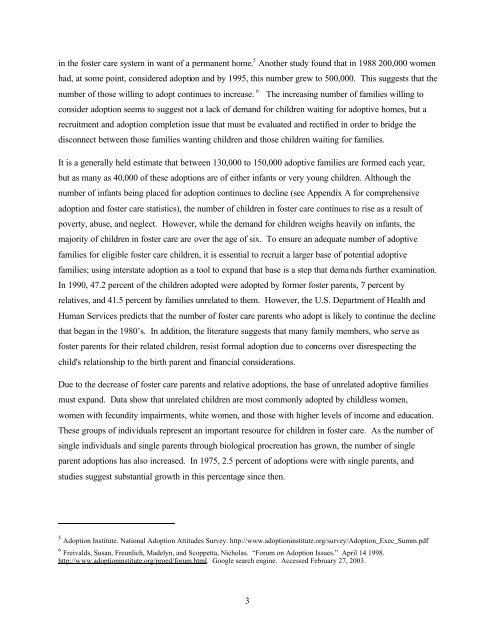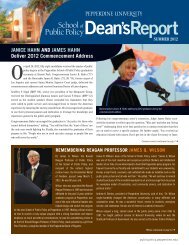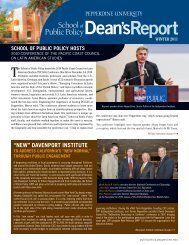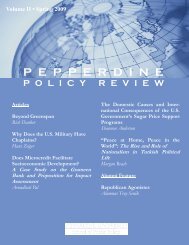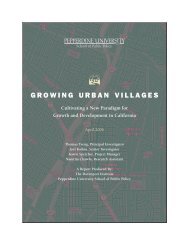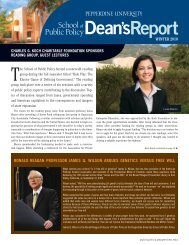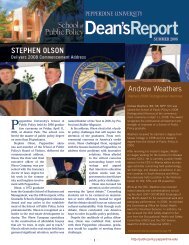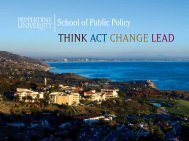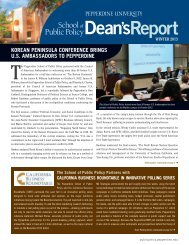Finding Permanent Homes for Adoptable Children - Pepperdine ...
Finding Permanent Homes for Adoptable Children - Pepperdine ...
Finding Permanent Homes for Adoptable Children - Pepperdine ...
You also want an ePaper? Increase the reach of your titles
YUMPU automatically turns print PDFs into web optimized ePapers that Google loves.
in the foster care system in want of a permanent home. 5 Another study found that in 1988 200,000 women<br />
had, at some point, considered adoption and by 1995, this number grew to 500,000. This suggests that the<br />
number of those willing to adopt continues to increase. 6 The increasing number of families willing to<br />
consider adoption seems to suggest not a lack of demand <strong>for</strong> children waiting <strong>for</strong> adoptive homes, but a<br />
recruitment and adoption completion issue that must be evaluated and rectified in order to bridge the<br />
disconnect between those families wanting children and those children waiting <strong>for</strong> families.<br />
It is a generally held estimate that between 130,000 to 150,000 adoptive families are <strong>for</strong>med each year,<br />
but as many as 40,000 of these adoptions are of either infants or very young children. Although the<br />
number of infants being placed <strong>for</strong> adoption continues to decline (see Appendix A <strong>for</strong> comprehensive<br />
adoption and foster care statistics), the number of children in foster care continues to rise as a result of<br />
poverty, abuse, and neglect. However, while the demand <strong>for</strong> children weighs heavily on infants, the<br />
majority of children in foster care are over the age of six. To ensure an adequate number of adoptive<br />
families <strong>for</strong> eligible foster care children, it is essential to recruit a larger base of potential adoptive<br />
families; using interstate adoption as a tool to expand that base is a step that dema nds further examination.<br />
In 1990, 47.2 percent of the children adopted were adopted by <strong>for</strong>mer foster parents, 7 percent by<br />
relatives, and 41.5 percent by families unrelated to them. However, the U.S. Department of Health and<br />
Human Services predicts that the number of foster care parents who adopt is likely to continue the decline<br />
that began in the 1980’s. In addition, the literature suggests that many family members, who serve as<br />
foster parents <strong>for</strong> their related children, resist <strong>for</strong>mal adoption due to concerns over disrespecting the<br />
child's relationship to the birth parent and financial considerations.<br />
Due to the decrease of foster care parents and relative adoptions, the base of unrelated adoptive families<br />
must expand. Data show that unrelated children are most commonly adopted by childless women,<br />
women with fecundity impairments, white women, and those with higher levels of income and education.<br />
These groups of individuals represent an important resource <strong>for</strong> children in foster care. As the number of<br />
single individuals and single parents through biological procreation has grown, the number of single<br />
parent adoptions has also increased. In 1975, 2.5 percent of adoptions were with single parents, and<br />
studies suggest substantial growth in this percentage since then.<br />
5 Adoption Institute. National Adoption Attitudes Survey. http://www.adoptioninstitute.org/survey/Adoption_Exec_Summ.pdf<br />
6 Freivalds, Susan, Freunlich, Madelyn, and Scoppetta, Nicholas. “Forum on Adoption Issues.” April 14 1998.<br />
http://www.adoptioninstitute.org/proed/<strong>for</strong>um.html. Google search engine. Accessed February 27, 2003.<br />
3


